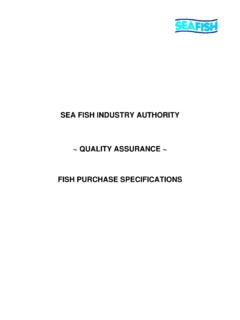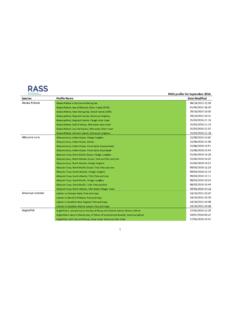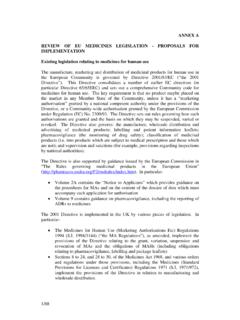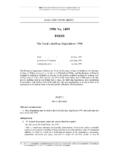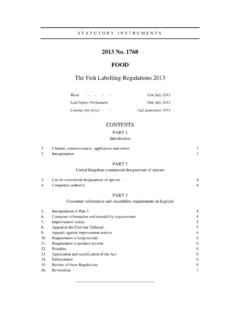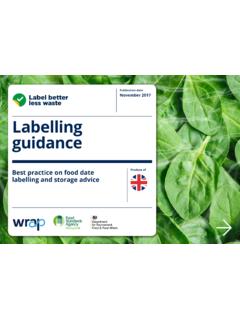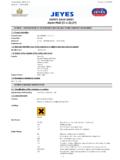Transcription of Omega-3 Labelling and the Nutrition and Health …
1 1 Omega-3 Labelling and the Nutrition and Health Claims RegulationsFact SheetThis guidance note provides information that may be relevant to companies wishing to make claims about the Omega-3 content of their products and/or any Health benefits associated with legal requirement for making this type of claim is in the process of changing. During this transition period some of the old rules remain and some new rules will come into guidance only gives information on the rules that relate to Omega-3 Labelling . Other rules may apply to other claims that you wish to make. The information given in this guide was taken from the Food Standards Agency (FSA) guide to compliance, which can be found at: While every effort has been made to give the correct advice, the need to summarise the information and make it relevant to the use of Omega-3 claims may have led to some minor differences.
2 Where inconsistencies are present, and these effect your Labelling decisions, the Agency guide should take precedence. References to the relevant section of the FSA guide are given under each European Nutrition and Health Claims Regulation EC 1924/2006 (NHCR) came into force on 1 July 2007. It controls any Nutrition , Health and disease reduction claims made about a food. It does not just apply to Labelling , but all types of commercial this legislation came into force, the national law of the Member State applied. In the UK this was consumer protection legislation in the form of the Food Labelling Regulations 1996 and the Food Safety Act 1990; these require that Labelling should not be false or misleading and claims for disease reduction are not permitted.
3 Some of these laws remain during the transition period for the new Regulation. However, it was and will remain for the courts to decide whether a claim is misleading under the relevant document is not a definitive interpretation of the law, which only the courts can provide. It is the responsibility of the individual business to ensure compliance with the law. The first version of this fact sheet was written in November 2008. The fact sheet has now been updated to include the latest developments up to July 2009 FAQ on compliance p 2-4 Omega-3 and Nutrition claims timeline p 5 LegislationLast updated: August 200921.
4 What is a commercial communication?[FSA guide Section (page 14), section (page 44)]The Regulation only applies to positive claims made in commercial communications aimed at the final consumer. These are any way that information is passed to the consumer with the aim of influencing the consumer to purchase or use a product. Examples of what is and is not commercial are given in the FSA , in some cases it is not easy to determine if a communication is commercial. If there is a benefit to a company whether directly or indirectly then it would be seen as commercial. For example, if a seafood processor promotes his product through a general Health article, on the benefits of Omega-3 in a magazine, or advertises in the same field of vision of such an article, then this would be commercial.
5 The same article written with no particular product association or promotion would not be What is a Nutrition claim?[FSA guide Section (page 11)A Nutrition claim is a claim that a food contains a particular nutrient, or words or pictorial representations that could be taken to mean the same thing. Declarations of the presence of a nutrient or ingredient that are required to be made by law1 or declarations in a Nutrition panel such as of Omega-3 per 100g are not Nutrition claims. Only beneficial claims aimed at selling the product are considered to be Nutrition claims so high in fat would not be considered a claim in most products whereas low in fat would be.]
6 This may depend on the product on which the claim is made. Omega-3 content claims are likely to be Nutrition claims. To make a Nutrition claim, the claim must be included in the annex to the NHCR. The generic claim that a food contains a named nutrient is already included in the annex, so if you wish to make this claim, you must comply with the provisions of the of the requirements of the NHCR for making a Nutrition claim is that the food contains significant amounts of the named nutrient to be a benefit to Health . This would apply to companies wishing to make a contains Omega-3 claim. What is deemed to be a significant amount is the amount that can be expected to produce the desired effect taking into account what quantities will be eaten.
7 As there is no Recommended Daily Amount established for Omega-3 , it would be advisable to use the amounts approved for the Joint Health Claims Initiative (JHCI)* claim to avoid making a misleading claim.*JHCI - see page 33. What Nutrition claims for Omega-3 can I make on my products and within what time frame will the rules be applied?[FSA guide Section (page 22), section (page 23), Q60 (page 56)]The annex to the Regulation includes a generic claim of contains that could be used for Omega-3 (see ). It is the Agency s view that source of would mean the same as contains to the average consumer and should be treated as the same claim and therefore comply fully with the NHCR.
8 For other Nutrition claims that are not included in the annex there are agreed transitional arrangements. These allow any claims made before 1 January 2006 and not included in the annex of the NHCR to continue to be used until 19 January 2010. Nutrition claims new to the market from 1 January 2006 must comply with the regulation or be taken off the market by 31 July 2009. High in Omega-3 was not included in the original annex, but as it is the claim not the product that must have been in use before this date, then new products can claim to be high in Omega-3 until 19 January 2010. These claims must comply with existing food law which are the Food Labelling Regulations 1996 and the Food Safety Act 1990.
9 Although in the case of Omega-3 the use of the JHCI conditions for making a claim would prevent a misleading of July 2009 this has changed and the proposal is now to include the claims source of Omega-3 and high in Omega-3 within the annex. These will be set at 15% and 30% respectively of the recommended daily intake (RDI). The RDI is 200mg/day for long chain PUFA (polyunsaturated fatty acids) and 2000mg/day for short chain PUFA. The scientific opinion is that short chain PUFA do not confer the same Health benefits as long chain PUFA and should not be included in any Omega-3 claim. 1 For example where the nutrient has been added and so must be included in the name of the updated August 20093 Scientific opinion is also that RDI for long chain PUFA should be 400-500mg day.
10 Because of the concerns over the details of the Omega-3 amendments, the amendments to the annex have been delayed while further evidence in assessed. This may mean that the transition period for existing claims ( as explained above ) will expire before the new claim is approved and comes into force. As no extension to the transition period has been discussed, it is hoped that the authorities will take a pragmatic approach in allowing existing claims to be used until the new claims come into force. 4. What is a Health claim?[FSA guide Section (page 7), section (page 12)]A Health claim states that the food or a nutrient it contains has a named Health benefit.
